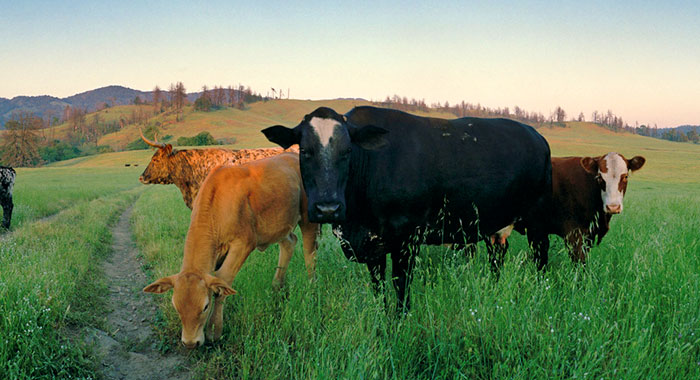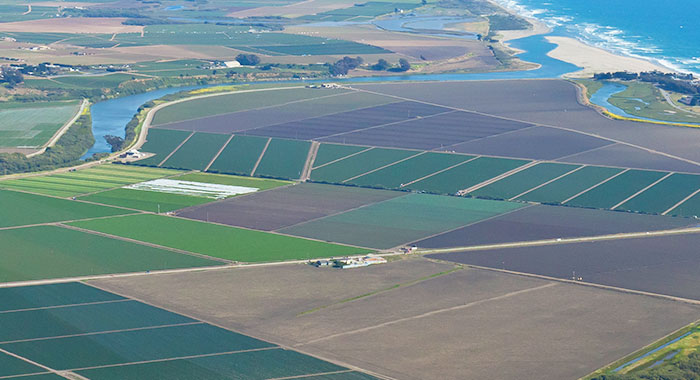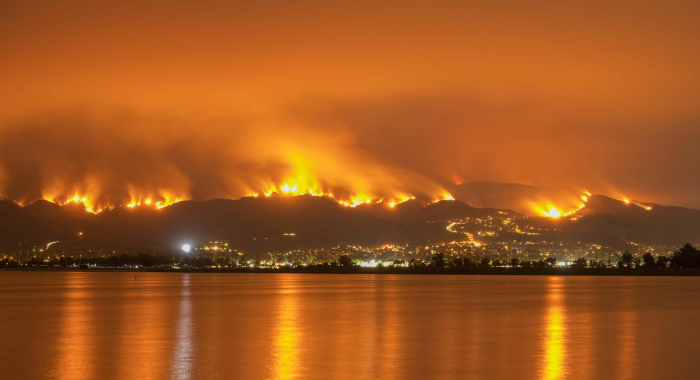In California, a day’s drive can take a visitor from record-setting desert heat to glaciated peaks to temperate rainforests with the world’s tallest trees. This astounding climatic and landscape diversity has helped create a biodiversity hotspot. California is also an economic hotspot – the 6th largest economy in the world – and is home to nearly 40 million people. The demand for land for new development and farms, along with accelerating climate change, puts tremendous stress on ecosystems, and the benefits they provide.
The state’s legacy of conservation has created a network of natural and working lands that benefit people by supplying clean water, capturing carbon, and directly contributing to the state’s economic and cultural vitality through recreation, tourism, and agricultural production. Conservancy scientists work across the spectrum of ecosystem types and human land uses, to advance conservation goals that also contribute to the well-being of people in those places.






Sophie S. Parker, Lily N. Verdone, E.J. Remson, Brian S. Cohen
This study addresses a basic problem shared by many riparian conservation projects: parcelization. Having dozens or hundreds of owners along a river can make conserving riparian ecosystems a difficult…M.B. Pesendorfer, T.S. Sillett, W.D. Koenig, S.A. Morrison
Many corvids are renowned as “ecosystem engineers” because they facilitate the long-distance seed dispersal of keystone tree species like oaks. This paper reviews research into various…Buchalski, M.R, B.N. Sacks, D.A. Gille, M.C.T. Penedo, H.B. Ernest, S.A. Morrison, W.M. Boyce
Bighorn sheep occupy a desert landscape of rugged mountains separated by expansive and very arid valleys. Highways and other development in those valleys fragment habitat and isolate populations from…Morrison, S.A., A.J. DeNicola, K. Walker, D. Dewey, L. Laughrin, R. Wolstenholme, N. Macdonald
This paper describes a program to eradicate an introduced and rapidly increasing population of wild turkeys from an island. It includes a description of the principles important for eradication…The Nature Conservancy and Sonoma County Agricultural Preservation and Open Space District
The Climate Action Through Conservation project provides a way for local governments, land managers, and planners to understand the links between climate benefits and conservation values and…Matthew G. Johnson, Kylene Lang, Paul Manos, Greg H. Golet, Kristina A. Schierenbeck
When non-native ornamental species spread into wild landscapes they can displace natives that have greater wildlife habitat value. Controlling the spread of a non-native species can be difficult when…Vasilissa V. Derugin, Joseph G. Silveira, Gregory H. Golet, Gretchen LeBuhn
In restoration ecology, understanding how and when species colonize newly created habitat is critically important for assessing progress toward restoration goals. By using camera traps to take a…Gary L. Ivey, Caroline P. Herziger, David A. Hardt, Gregory H. Golet
Understanding the geographic distribution and long-term dynamics of Sandhill Crane (Grus canadensis) foraging areas and night roost sites is fundamental to their conservation and management. The…Daniel S. Karp, Patrick Baur, Edward R. Atwill, Kathryn De Master, Sasha Gennet, Alastair Iles, Joanna L. Nelson, Amber R. Sciligo, Claire Kremen
In 2006, an E. coli outbreak linked to spinach grown in California’s Central Coast region catalyzed reforms in vegetable production. Without evidence, wildlife was targeted as a disease vector…Jason Kreitler, Carrie A. Schloss, Oliver Soong, Lee Hannah, Frank W. Davis
In the past, mitigation to address impacts from development have lacked a regional planning perspective resulting in efficient design across a set of sites for a suite of impacts. This paper…W. David Shuford , Matthew E. Reiter, Khara M. Strum, Michelle M. Gilbert , Catherine M. Hickey, Greg Golet
Although agricultural intensification is one of the largest contributors to the loss of global biodiversity, agricultural landscapes can provide valuable habitat for birds. Recognizing this, wildlife…Johnston, A., D. Fink, M. D. Reynolds, W. M. Hochachka, B. L. Sullivan, N. E. Bruns, E. Hallstein, M. S. Merrifield, S. Matsumoto, S. Kelling
Global declines in migratory species in response to accelerating habitat destruction and climate change challenge the scope and scale of conservation efforts. The ability to pinpoint where and when…Cause Hanna, Ida Naughton, Christina Boser, David Holway
Ecological invasions can shift species composition and even alter ecosystem function. Ant invasions generate a broad spectrum of ecological effects but there is controversy about the extent of these…Daniel S. Karp, Sasha Gennet , Christopher Kilonzo, Melissa Partyka, Nicolas Chaumont, Edward R. Atwill, Claire Kremen
In 2006, a high profile outbreak of E. coli in spinach was traced to California’s Central Coast. After that outbreak, produce growers were pressured to minimize potential presence of wild…Derek Young
A century of fire suppression has dramatically altered the structure and composition of western U.S. forests. When dense, fire-suppressed forests experience wildfire, they often burn severely. To…Vickers, T.W., J. N. Sanchez, C. Johnson, S.A. Morrison, R. Botta, T. Smith, B.S. Cohen, P. Huber, W.M. Boyce
Conservation of wide-ranging species like mountain lions is especially difficult in highly fragmented landscapes, such as coastal southern California. Research into their populations can provide…